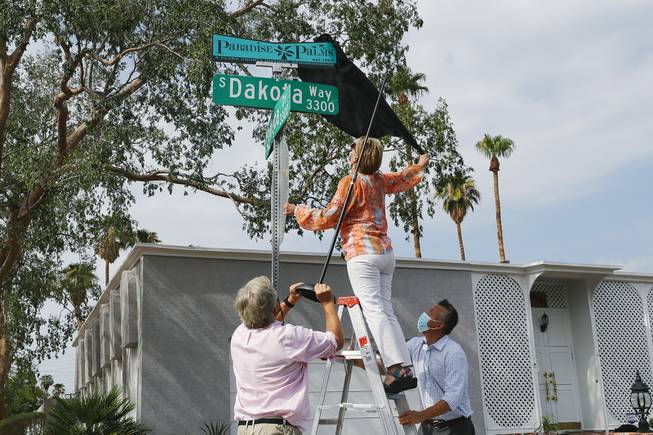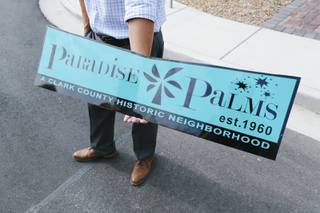
From left, Clark County Commissioner Tick Segerblom, former County Commissioner Chris Giunchigliani and neighborhood organizer Dave Cornoyer unveil a street sign topper during an event in the historic Paradise Palms neighborhood Wednesday, Sept. 1, 2021.
Thursday, Sept. 2, 2021 | 2 a.m.
New street signs in the Paradise Palms neighborhood of Las Vegas show hyperlocal pride and a commitment to history that its residents know can be hit and miss in this ever-reinventing city.
Paradise Palms, in the heart of Las Vegas hugging the Las Vegas National Golf Course, retains the everyday glamour of the early 1960s that it was built in. Charm fairly blows through the breezeblock and the half-moon driveways under the towering skinny palms that were the de rigueur landscaping.
Neighborhood resident Dave Cornoyer said the Racquet Club Road Estates in Palm Springs, Calif. — a town that’s a mecca of mid-century modern architecture — is Paradise Palms’ sister development, and it has similar placemaking signs. “We saw that identity there and we wanted that here,” he said.
“This is our Palm Springs,” said Clark County Commissioner Tick Segerblom, who represents the area, before helping whip the black cloth off the first sign on Wednesday at Dakota Way and Seneca Drive. “This is a gorgeous, gorgeous neighborhood.”
Not just upholding an aesthetic of a bygone era, Paradise Palms is also officially classic thanks to a county designation as an historic overlay district. With that title, it is allowed to top its functional street signs with fun markers proclaiming the neighborhood’s name.
The signs are the first of their kind in unincorporated Clark County, and were created with care off and on over the last four years: cut with the M-shaped silhouette of a butterfly roof from extra-thick aluminum to withstand the valley’s buffeting winds, in a deep shade of blue-green known as “signature Paradise Palms turquoise” and jazzed up with Jetsons-esque stars.
“It is truly iconic,” said Segerblom’s predecessor Chris Giunchigliani, who helped initiate the historic overlay district designation. “I love the design.”
Cornoyer, a one-time city planner, shepherded the sign project. Neighbors paid for it themselves, pooling about $7,000 for county workers to erect 27 signs on about 10 streets.
The first was on a street that held model homes in what was Las Vegas’ first master-planned community — a pocket of about 1,000 homes over about 700 acres bound between Eastern Avenue and Maryland Parkway to the east and west and Desert Inn Road and Twain Avenue to the north and south. When the homes were new, business and gaming elite of the era lived here, along with entertainers: Phyllis Diller, Johnny Carson, Debbie Reynolds and Rip Torn; Howard Hughes’ right hand, Robert Maheu; Frank “Lefty” Rosenthal, the man the epic film “Casino” is based on — and perhaps not coincidentally, the split-level prominently featured as the home of the character he inspired, Sam Rothstein, is also in Paradise Palms, on a double-frontage cul-de-sac lot on Cochise Lane.
Last year, the neighborhood’s 60th anniversary, would have been a good time to post the signs, but the coronavirus pandemic put a pin in that.
More corners of Paradise Palms are in the pipeline to receive historic designation, and signs will be coming there too. Now that he’s familiar with the process, those signs should pop up quicker, Cornoyer said.
He said he knows Las Vegans aren’t known for embracing their history and sense of place.
Tapping a sign and making the metal ping, he said, “we do.”

